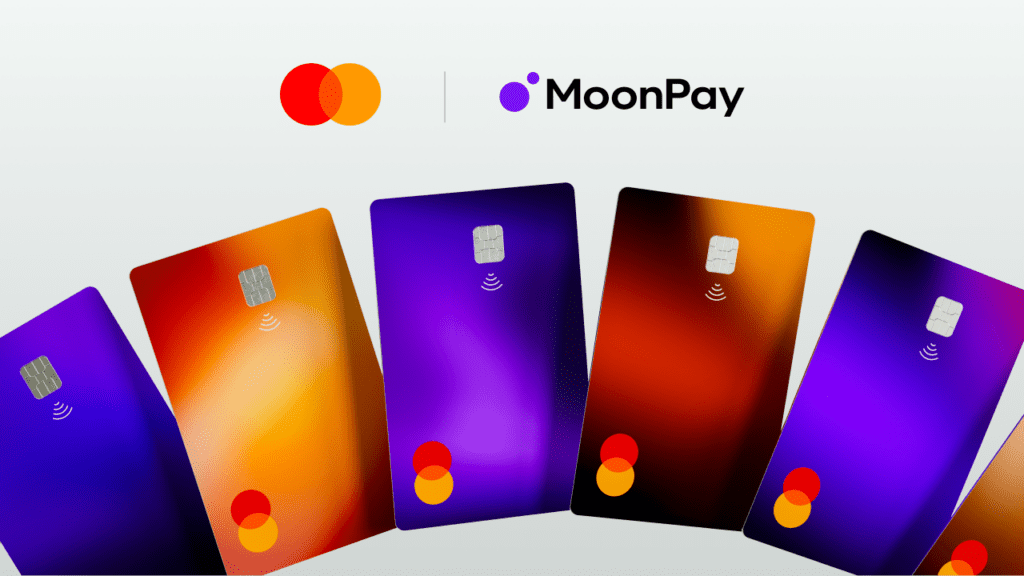- Crypto payment cards via Mastercard and MoonPay empower Africa’s unbanked by converting stablecoins to fiat at 150M global merchants.
- Gig workers in Nigeria, Kenya, and South Africa now access instant cross-border payments via stablecoin cards, bypassing high remittance fees.
- Africa’s 43% stablecoin transaction dominance drives crypto payment card adoption, reshaping SMEs’ access to global markets and financial services.
The financial landscape is being redefined by crypto payment cards, with global payment organizations like Visa and MasterCard and mobile payment platforms like PayPal incorporating digital assets.
The latest update is the Moonpay MasterCard partnership, as both organizations collaborate to bridge the gap between digital assets and traditional finance.
As per the announcement, users of Moonpay will now be able to spend stablecoins through MasterCard-branded cards, tapping into its 150 million merchant network.
This collaboration showcases the seismic shift toward universal adoption of blockchain-based payments.
Mastercard Partners with MoonPay to Revolutionize Crypto Payment Cards Landscape
MoonPay Mastercard Partnership: Bridging Stablecoins and Traditional Finance
At the heart of the Moonpay Mastercard partnership is the single vision to empower fintech and enterprises with the vast reach of stablecoin wallets.
The crypto payment cards will leverage Iron’s API-driven infrastructure, acquired by Moonpay in March 2024, enabling automatic conversion of stablecoins like USDC and USDT into local fiat currencies.
MoonPay is an African-based platform rivaling the likes of Yellow Card to dominate Africa’s growing remittance industry.
This new collaboration gives organizations an edge as it simplifies stablecoin card transactions, dividing the gap between digital assets and everyday consumption by half.
CHECK OUT”: Stripe Stablecoin Accounts: Why 25 African Nations Just Got Financial Freedom
Scott Abrahams, Mastercard’s Executive Vice President of Global Partnerships, emphasized the strategic importance of the collaboration:
“By providing solutions that unlock stablecoin utility and ubiquity, we’re redefining how money moves globally. Together with MoonPay, we’re building innovative and secure connectivity between crypto and mainstream finance ecosystems, grounded by trust and driven by scale.”
How Stablecoin Card Transactions Work
To maximize useability and possibly tap into Africa’s growing stablecoin market, accounting for 43% of total crypto transaction volume in 2024-2025, the process is straightforward.
Users link their wallets to MasterCard-issued crypto payment cards, enabling instant conversion of their assets into local currency during transactions.

Iron API-driven conversion slashes settlement times and eliminates intermediaries for streamlined transactions.[Photo: MoonPay]
MoonPay’s CEO, Ivan Soto-Wright, highlighted the broader implications:
“MoonPay serves the largest crypto wallets in the industry, and with MasterCard, we’re bringing convenient, trusted stablecoin-enabled cards to crypto users worldwide. Our acquisition of Iron and long-standing relationship with MasterCard allow us to power a new era of payments made with stablecoins at more than 150 million merchant locations worldwide.”
Mastercard Stablecoin Integration and API Payment Rails
A key factor to this partnership is MasterCard stablecoin integration, tapping into Moonpay’s extensive network of 500+ crypto platforms.
Iron’s API stablecoin payments rules connect millions of wallets across exchanges, allowing seamless transfers without the hurdles of additional financial infrastructure.
One of its main selling points is its interoperability, a vital edge, especially within Africa’s underbanked regions where stablecoins have become a growing alternative to traditional banking.
For instance, in regions like Nigeria, Kenya and South Africa, stablecoin card transactions enable easy access to funds and transaction features.
Its ability to convert assets into spendable funds via crypto payment cards bypasses numerous bureaucratic hurdles and accumulates fees associated with multiple remittance channels.
Benefits of Stablecoin Cards for Gig Workers
A growing sector within Africa’s abundant human capital sector is the gig industry, encompassing entrepreneurs, freelancers and content creators.
Cross-border disbursements, often slow and costly, can now be completed using stablecoin card transactions in seconds.
Platforms leveraging Moonpay’s infrastructure can issue crypto payment cards to contractors, ensuring instant access to funds without currency conversion hassles.
CHECK OUT: Africa’s Fintech Trifecta: Circle, Flutterwave & Yellow Card Join Forces
In addition, Mastercard’s compliance and fraud detection tools are a badge of trust, ensuring each transaction is protected and avoiding various disappearing acts gig workers have faced in the past.
The continent’s dependency on stablecoins has significantly grown. John Egan, Stripe’s head of crypto, noted the growing demand for stablecoins at the firm’s yearly conference.
“Within a week of turning on stablecoins last year, we saw transactions pour in from over 30 countries, and we processed more stablecoin transactions in that week than we did in an entire year and a half with Bitcoin back in 2015.”
The Future of Crypto Payment Cards
The fusion of Mastercard’s infrastructure and Moonpay’s crypto expertise and reach in Africa set up a new drive for adoption.
By simplifying how to spend stablecoins with card systems, individuals and businesses have new access to markets, a better payment system and a blueprint for Blockchain’s role in mainstream finance.
At this pace, stablecoins will become as ubiquitous as debit cards and credit cards, more so in Africa, where the fiat inflation rate is at an all-time high.
For gig workers, freelancers, and global citizens alike, the ability to transact seamlessly with stablecoins signals a democratization of financial access—one swipe at a time.

